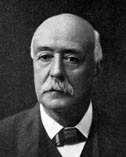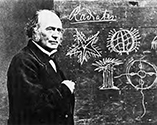
 Alexander Agassiz
Alexander Agassiz
1901-1907 NAS President
The next choice for president, made in 1901, was Alexander Agassiz (1835–1910), the scientist son of the Swiss immigrant Louis Agassiz (1807–1873). The latter was a charter member of the academy who had enjoyed a brilliant career in United States after gaining fame for research in Europe on the study and classification of fossil fish. He had also provided the first reasonable, scientifically comprehensive understanding of the great ice age and its distinctive effects upon geological features produced by the motion of the great glaciers of the past. The latter revolutionary work led, for example, to the explanation of the U-shaped nature of Yosemite Valley, first given by a young John Muir working as a temporary lumberman in the valley. Muir had heard Louis Agassiz lecture on the physical effects of the movement of glaciers while a student at the University of Wisconsin but had great difficulty selling the concept to the well-established American geologists of the time.
 Louis (pictured right) came to United States to deliver lectures in Boston in 1846 and, liking the challenging environment, decided to stay after receiving an appointment as a member of the Harvard faculty. He was lionized in America as a world-class European scientist. He was soon omnipresent on the American scientific scene and was universally regarded as one of the particularly “elite” members of the scientific community, a status to which he did his best to conform. He became a regent of the Smithsonian and received many other honors. The elder Agassiz exhibited one major idiosyncrasy: he had significant doubts about Darwin's theory of evolution. His son did not share these doubts. The leading naturalist of the time, Alexander von Humboldt, regretted Louis Agassiz's shift from fossil fish to glaciers since he had more interest in fish. Apparently Agassiz had very acute vision and could distinguish minor differences between fossilized species.
Louis (pictured right) came to United States to deliver lectures in Boston in 1846 and, liking the challenging environment, decided to stay after receiving an appointment as a member of the Harvard faculty. He was lionized in America as a world-class European scientist. He was soon omnipresent on the American scientific scene and was universally regarded as one of the particularly “elite” members of the scientific community, a status to which he did his best to conform. He became a regent of the Smithsonian and received many other honors. The elder Agassiz exhibited one major idiosyncrasy: he had significant doubts about Darwin's theory of evolution. His son did not share these doubts. The leading naturalist of the time, Alexander von Humboldt, regretted Louis Agassiz's shift from fossil fish to glaciers since he had more interest in fish. Apparently Agassiz had very acute vision and could distinguish minor differences between fossilized species.
Alexander Agassiz, who served as president of the Academy for six years, had for the most part been raised and educated in Europe. However, on settling in United States, he accepted a position at the Museum of Comparative Zoology at Harvard, which he retained throughout his career, ultimately becoming its director. As a significant side interest, he became involved commercially for a period in the development of the Calumet and Hecla copper mines in Michigan. He found them poorly managed and on the verge of being bankrupt. He entered the picture as a diligent dedicated businessman who merged the two mines and introduced much more efficient equipment. He became a young independently wealthy scientist who was free to pursue any interest or activity he desired. He was devastated by the early death of his wife and decided to change his style of life. He took full advantage of the freedom going with bachelorhood and roamed the world systematically on a variety of scientific missions of his own choosing. He accepted the appointment as president of the Academy with the understanding that he would retain much of his personal freedom of action.
President Grover Cleveland, who previously had little interest in science, became enamored with the subject after making the acquaintance of Alexander Agassiz and offered him the position of Scientific Advisor to the President of the United States in his administration. Agassiz begged off on the basis of age and health, but his real reason probably lay in the fact that the demands of the post would have disrupted well-laid plans for his personal research.
There was some unrest and associated disputation concerning the relative magnitude of the roles that the government-based scientists in Washington should play in Academy affairs. This issue seems to have vanished by the 1920s as the national community of academic scientists grew very large and self-assertive.
 Revolution In Physics
Revolution In Physics
Early in the 1890s, following the development of electromagnetic theory, many individuals thought that the field of physics had finally attained maturity, and that future activity in it would merely involve filling out what might be called connecting gaps. Actually, the world of physics was effectively reborn during the relatively short period between 1895 and 1907 in which Gibbs and Agassiz held office. The field started on new journeys that have continued to provide expectations of major unforeseen revelations up to the present. The members of the Academy approached 1913, its semi-centennial year, with the realization that the scientific endeavor was still very young and that great discoveries lay ahead, some important for enlightenment, others for the advance of technology.
Agassiz's term of service is distinguished by the addition of a section of the Academy in the field of psychology.
Continue reading next chapter: Ira Remsen

